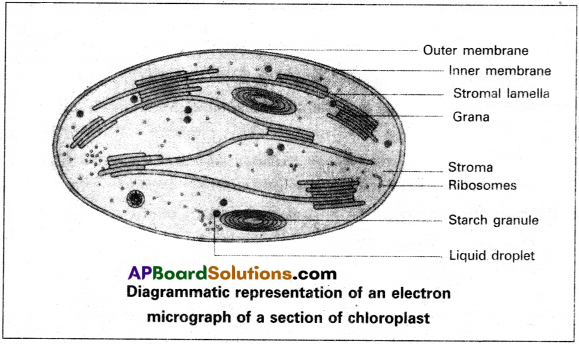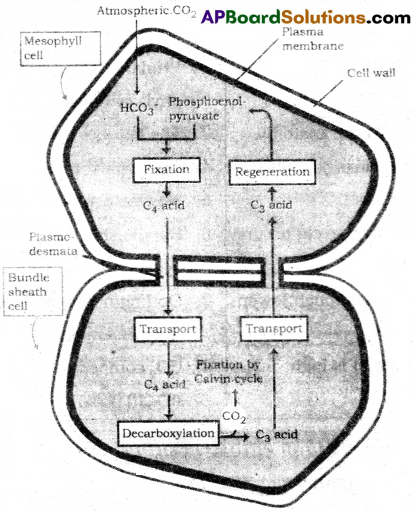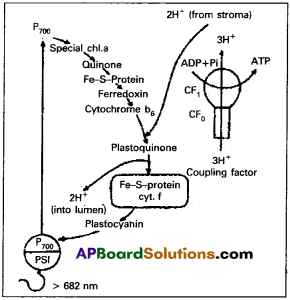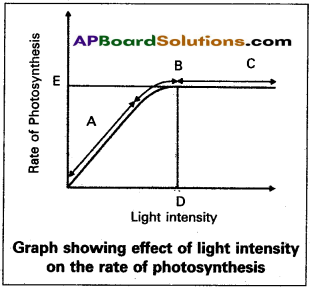Andhra Pradesh BIEAP AP Inter 2nd Year Botany Study Material 4th Lesson Photosynthesis in Higher Plants Textbook Questions and Answers.
AP Inter 2nd Year Botany Study Material 4th Lesson Photosynthesis in Higher Plants
Very Short Answer Questions
Question 1.
Name the processes which take place in the grana and stroma regions of chloroplasts.
Answer:
The processes that take place in the grana and stroma regions of chloroplasts are :
Trapping of light energy is used for the synthesis of ATP and NADPH occurs in the grana regions of the chloroplast, whereas enzymatic reactions incorporate CO2 into the plant, leading to the synthesis of sugar occurring in the stroma region of the chloroplast.
Question 2.
Where does the photolysis of H2O occur? What is its significance?
Answer:
Photolysis of water occurs in the grana of the chloroplast. It splits into protons, electrons, and oxygen. This creates oxygen which is one of the net products of photosynthesis.
Question 3.
How many molecules of ATP and NADPH are needed to fix a molecule of CO2 in C3 plants? Where does this process occur?
Answer:
3 ATP and 2 NADPH are needed. It occurs in stroma of the chloroplast.
Question 4.
Mention the components of ATPase enzyme. What is their location? Which part of the enzyme shows conformational change?
Answer:
The ATPase enzyme consists of 2 parts:
One called F0 is embedded in the membrane, that carries out facilitated diffusion of protons across the membrane. The other part is called F1 which protrudes out into the stroma. F1 particle of the ATPase shows confirmational change.
![]()
Question 5.
Distinguish between Action Spectrum and Absorption Spectrum.
Answer:
| Action Spectrum | Absorption Spectrum |
| A graph showing the rate of photosynthesis by as a function of wavelengths of light. | A graph showing the absorption of light by Pigment as a function of wavelengths of light. |
Question 6.
Of the basic raw materials of photosynthesis, what is reduced? What is oxidised?
Answer:
CO2 is reduced. Water is oxidised.
Question 7.
Define the law of limiting factors proposed by Blackman.
Answer:
In a process participated by a number of seperate factors, the rate of the process is limited by the factor which is present in minimal value.
Question 8.
What is the primary acceptor of CO2 in C3 plants? What is first stable compound formed in Calvin Cycle?
Answer:
Primary acceptor of CO2 in C3 plants is RUBP. First stable compound formed is PGA (3C).
![]()
Question 9.
What is the primary acceptor of CO2 in C4 plants. What is the first compound formed as a result of primary carboxylation in the C4 pathway?
Answer:
Primary acceptor of CO2 in C4 plants is PEPA.
First compound formed is = OAA (4C).
Short Answer Questions
Question 1.
Draw a neat labelled diagram of chloroplast.
Answer:

Question 2.
Tabulate any eight differences between C3 and C4 plants/cycles.
Answer:
| C3 plants | C4 plants |
| 1. Primary or first product of carbon path- way is 3c compound phospho glyceric acid (PGA). | 1. First product of carbon pathway is 4 – c compound oxaloacetic acid. |
| 2. CO2 acceptor is RuBP in Mesophyll chloroplast. | 2. Primary CO2 acceptor is PEP in Meso- phyll cytoplasm. |
| 3. Leaves do not show Kranz anatomy. | 3. The leaves have kranz anatomy. |
| 4. Chloroplast dimorphism is not present. | 4. Chloroplast dimorphism is present. |
| 5. Photorespiration occurs. | 5. No photorespiration. |
| 6. Cell type in which calvin cycle occurs is mesophyll. | 6. Bundle sheath. |
| 7. Optimum temperature is much lower. Ex: Mango. |
7. Optimum temperature is high. Ex: Zea mays. |
| 8. CO2 compensation point is high. (25 to 100 ppm) |
8. CO2 compensation point is low. (0-10 ppm) |
Question 3.
Describe C4 pathway.
Answer:
H.PKortschak and C.E Hartt found that in sugarcane the first products of photosynthesis were acids containing 4 – c atoms, rather than the 3c – acid. The same has been found true for many tropical plants.
Ex : Maize, Elensine, Sorghum, Amaranthus & Euphorbia etc. These plants are called C4 plants. Hatch and Slack explained the manner of CO2 fixation and reduction in such plants.
The leaves of C4 plants show Kranz anatomy, means ‘wreath’ there vascular bundles are surrounded by two rings of cells, i) Bundle sheath cells 2) Mesophyll cells.
- In C4 – pathway, the primary acceptor of CO2 is phospjioenol pyruvic acid (PEP) and which is converted into oxaloacetate in the presence of enzyme PEP carboxylase.
- The oxaloacetate is converted into malate or aspartate depending upon the species.
- The malate formed in mesophyll cells is transferred to the neighbouring bundle sheath cells via plasmodesmata between these cells.
- In the bundle sheath cell the malate is now decarboxylated producing pyruvate and CO2 by action of NADP specific malic enzyme.
- In the bundle sheath cells the CO2 arising from the decarboxylation of malate is now fixed again in exactly the same calvin pathway of C3 plants.
- Sucrose & starch are ultemately formed from 3 PGA in bundle sheath cells.
- The pyruvate formed by decarboxylation of malate in the bundle sheath is transported bock to the mesophyll cells where it is converted into phosphoenol pyruvate by the action of enzyme pyruvate phosphate dikinase.

Question 4.
Describe in brief photorespiration.
Answer:
- Photorespiration is a light dependent release of CO2 and uptake of O2 by the green tissue of particularly C3 plants. To understand photorespiration we must know first step in calvin cycle. In which RuBP combines to form 2 molecules of 3PGA that are catalysed by RuBiSCO.
- RuBiSCO is the most abundant enzyme in the world. It has active site can bind to both CO2 and O2. RuBiSCO has a much greater affinity for CO2 than O2.
- In C3 plants some O2 does bind to RuBiSCO and hence CO2 fixation is decreased. Here the RuBP instead of being convert 2 molecules of PGA, binds with O2 to form one molecule of phosphoglycerate and phosphoglycolate in pathway called photorespiration.
- In photorespiration there is no synthesis of ATP or NADPH & sugars. Therefore, photorespiration is a wasteful process.
- In C4 plants photorespiration does not occur. This is because they have mechanism that increase the cone of CO2 at the enzyme site.
Long Answer Questions
Question 1.
In the light of modem researches describe the process of electron transport, cyclic and non-cyclic photopnosphorylation.
Answer:
Electron transport and mechanism of ATP formation :
The synthesis of ATP from ADP and Pi in presence of light within the chloroplast is called photophosphorylation. It is of two types-viz., non – cyclic photophosphorylation and cyclic photophosphorylation.
Non – cyclic photophosphorylation:
In chloroplasts, the electrons continuously supplied from water, are transported to photosystem-II, to photosystem-I and finally to NADP+ which is reduced to NADPH. This transport of electrons is called non-cyclic electron transport. Formation of ATP in association with non-cyclic electron transport is called non-cyclic photophosphorylation.
Non – cyclic electron transport requires two large, multimolecular complexes called as photosystem -I and photosystem – II. The two complexes operate in series and are linked by electron carrier molecules. The photo systems and electron carriers are arranged in the thylacoid membranes of chloroplasts.
Photosystem-I consists of several molecules of chlorophyll a, some molecules of chlorophyll b and some β – carotene molecules. The reaction centre of PS -I consists of four to six molecules of chlorophyll a and is designated as P700. Light harvesting complex I (chlorophyll – protein complexes) is associated with PS I. PS I is activated by red light of longer wavelength (> 682 nm) when PS I absorbs red light, the absorbed light energy is transferred to P700.
It is first excited and then oxidized. The electron released from P700 is transferred to a special chlorophyll a. The electron is then passed through quinone and Fe – S – proteins and finally to ferredoxin. From ferredoxin, electron is transferred to NADP+ which is reduced to NADPH. This reduction takes place in the stroma and catalysed by the enzyme ferredoxin NADP+ oxidoreductase.
Photosystem – II consists of several molecules of chlorophyll a, some molecules of chlorophyll b and some β – carotene molecules. The reaction centre of PS – II consists of four to six molecules of chlorophyll a and is designated as P680. Light harvesting complex – II is associated with PS – II. PS – IT is activated by red light of shorter wavelength (< 682 nm). When PS – II absorbs red light, the absorbed light energy is transferred to P680. It is first excited and then oxidised.
The electron released from P680 is transferred to pheophytin (a colourless chi. a molecule which lacks magnesium ion). From pheophytin electron is quickly transferred to quinone and then to plastoquinone, which requires two electrons. Reduced plastoquinone picks up two protons from stroma and moves from PS – II to cytochrome b6 f complex. Electrons from reduced plastoquinone are transferred first to Fe – S – protein and then to cytochrome f. Protons released from oxidised plastoquinone diffuse into lumen of thylacoid membrane. From cyt. f the electron is transported to plastocyanin (a mobile protein containing copper ion). From plastocyanin electron moves to P700 of PS – I, bringing it to reduced or normal state.
The electrons that reduce oxidised P680 are supplied by a cluster of four manganese ions which are associated with oxygen evolving Complex (OEC) proteins. OEC splits water and releases electrons and oxygen. OEC is located on the lumen side of thylacoid membrane. Cl– also bind to OEC.

The result of electron transport from water to PS – II and from PS – II to PS – I is accumulation of protons in the lumen of thylacoid membrane. The thylacoid membrane is impermeable to protons. Thylacoid membrane shows many proton channels called ATP synthase or coupling factors. A coupling factor consists of a basal, hydrophobic complex (CF0) and apical, hydrophilic complex (CF1). CF0 contains the active site for ATP synthesis and CF0 forms a proton channel across the membrane. When protons diffuse from thylacoid lumen into stroma through coupling factor, ATP is synthesised from ADP and Pi.

Cyclic photophosphorylation:
In chloroplasts, when sufficient amount of NADP+ is not available the electrons released from activated P700 of PS – I return to P700 through plastoquinone, cytochrome complex and plastocyanin. This electron transport is independent of PS – II and called cyclic electron transport. Formation of ATP associated with cyclic electron transport is called cyclic photophosphorylation.
![]()
Question 2.
Explain Calvin cycle.
Answer:
The plants in which the first stable product of photosynthesis is 3 – PGA are called C3 plants. The path of carbon in C3 plants was traced by Melvin Calvin, Benson and S.A. Bashaam (1945-1957).
The path of carbon in C3 plants can be represented in the form of a cycle called reductive pentose phosphate pathway or Calvin – Benson cycle or Photosynthetic Carbon Reduction (PCR) cycle. It takes place in stroma of the chloroplast and includes three main parts, namely carboxylation, reduction and regeneration.
I) Carboxylation:
The carbon atom of carbondioxide is first fixed by RuBP, A6 – Carbon unstable compound is formed. It is spontaneously hydrolysed into two molecules of PGA. The enzyme RuBP ase (Rubisco) catalyses the reaction. The enzyme is light activated.
II) Reduction :
The second part of path of carbon is reduction of PGA to phospho- glyceraldehyde. This part includes the following reactions.
- PGA is phosphorylated by phosphoglycero kinase to yield B is PGA. ATP donates the phosphate group.
- B is PGA is reduced by phosphoglycero dehydrogenase to yield phospho- glyceraldehyde. NADPH donates the hydrogen atoms. Energy rich phosphate group is released.
Some molecules of phosphoglyceradehyde are used to form starch.
III) Regeneration :
For the continuity of photosynthetic carbon reduction, the primary acceptor RuBP should be regenerated. Regeneration of RuBP takes place in three pathways.
First pathway:
- Some molecules of PGAL (3c) are isomerised by triose phosphate isomerase to yield DHAP (3c).
- Some molecules of DHAP and PGAL are condensed into fructose bis-phosphate (6c) by aldolase.
- Fructose bis – phosphate is dephosphoiylated into fructose monophosphate (6c) by . phosphatase. The enzyme is light activated. Energy rich phosphate radical is released.
- Fructose monophosphate reacts with PGAL to form xylulose monophosphate (5c)
and Eiythrose monophosphate (4c). Transketolase catalyses the reaction. - Xylulose monophosphate is epimerised into Ribulose monophosphate (5c) by phosphopentose epimerase.
- Ribulose monophosphate is phosphorylated by phosphoribulokinase to regenerate RuBP (5c). ATP donated the phosphate group. The enzyme is light activated.
Second Pathway:
- Erythrose monophosphate (4c) condenses with DHAP (3c) to form Sedoheptulose bisphosphate (7c) Aldolase catalyses the reaction.
- Sedoheptulose bis – phosphate is dephosphorylated byphosphatase into sedo-heptulose monophyosphate (7c). Energy rich phosphate radical is released. The enzyme is light – activated.
- Sedoheptulose monophosphate (7c) reacts with PGAL (3c) to form xylulose monophosphate (5c) and ribose monophosphate (5c). Transketolase catalyses the reaction.
- Xylulose monophosphate is epimerised by phosphopentose epimerase into Ribulose monophosphate (5c).
- Ribulose monophosphate is phosphorylated by phosphoribulokin-ase to regenerate RuBP. ATP donates the energy rich phosphate group. The enzyme is light activated.
Third Pathway:
- Ribose monophosphate (5c) is isomerised by phosphopentose isomerase into ribulose monophosphate.
- Ribose monophosphate is phosphorylated by phosphoribulokinase to regenerate RuBP. ATP donates the energy rich phosphate group. The enzyme is light activated.

Intext Questions
Question 1.
By looking at a plant externally, can you tell whether a plant is C3 or C4? Why and how?
Answer:
C4 plants have greater productivity of Biomass and can tolerate higher temperatures.
Question 2.
By looking at which internal structure of a plant can you tell whether a plant is C3 or C4? Explain.
Answer:
Large bundle sheath cells are present around the vascular bundles in C4 plants and the C4 plants are identified.
Question 3.
Even though a very few cells in a C4 plant carry out the biosynthetic – Calvin pathway, yet they are highly productive. Can you discuss why?
Answer:
In C4 plants CO2 fixation occur in two types of cells, mesophyll and bundle sheath cells so they are highly productive.
![]()
Question 4.
RUBisCO is an enzyme that acts as both as a carboxylase and oxygenase. Why do you think RUBisCO carries out more carboxylation in C4 plants?
Answer:
The bundle sheath cells in C4 plants are rich in RuBisCO but lack PEP case. Thus RuBisCO carries out more carboxylation.
Question 5.
Suppose there were plants that had a’ high concentration of chlorophyll b, but lacked chlorophyll a, would it carryout photosynthesis? Then why do plants have chlorophyll b and other accessory pigments?
Answer:
Yes, they carry out photosynthesis. Chlorophyll b, xanthophylls and caroteriods also absorb light and protects the chlorophyll a from photpoxidation.
Question 6.
Why is the colour of a leaf kept in the dark frequently yellow, or pale green? Which pigment do you think is more stable?
Answer:
If we kept the leaf in dark, photosynthesis does not occur so the leaf turns to yellow or pale green. Chlorophyll is the pigment more stable.
Question 7.
Look at leaves of the same plant on the shady side and compare it with the leaves on the sunny side. Or, compare the potted plants kept in sunlight with those in the shade. Which of them has leaves that are darker green? Why?
Answer:
The leaves of the plant kept in sunny side get more light to absorb and is utilised for photosynthesis become dark green than the plants kept on shady side.
Question 8.
Figure shows the effect of light on the rate of photosynthesis. Based on the graph, answer the following questions.
a) At which point/s (A, B or C) in the curve is light a limiting factor?
b) What could be the limiting factor/s in region A?
c) What do C and D represent on the curve?

Answer:
a) In Region ‘A’ Light is limiting factor where photosynthesis is minimum.
b) Light is the limiting factor in region A.
c) ’D’ shows the optimum point and gives the light intensity at which maximum photosynthesis is recorded. ‘C shows the rate of photosynthesis remains constant after this point even though the density of light changes.
![]()
Question 9.
Give comparison between the following :
a) C3 and C4 pathways
b) Cyclic and Non-cyclic photophosphorylation
c) Anatomy of leaf in C3 and C4 plants.
Answer:
a)
| C3 pathway | C4 pathway |
| 1. Plants in which CO2 is accepted by RUBP. | 1. Plants in which CO2 is accepted by PEPA. |
| 2. Plants in which the first product is PGA (3C) | 2. Plants in which the first product is OAA (4C). |
b)
| Cyclic | Non-cyclic |
| 1. PS I is involved. | 1. PS I and PS II are involved. |
| 2. It utilises red light of shorted and longer wavelength (700). | 2. It utilises red light of shorted and longer wavelengths (P700, P680). |
| 3. O2 is not evolved. | 3. O2 is envolved. |
| 4. One ATP is formed, NADPH is not formed. | 4. 1. NADPH and 2. ATP are formed. |
| 5. The electrons move in a closed cirlce. | 5. The electrons move in a zig-zag manner (z-scheme). |
c)
| C3 plants | C4 plants |
| 1. Leaves do not show Kranz anatomy. | 1. Leaves show Kranz anatomy. |
| 2. Chloroplast dimorphism is not present. | 2. Chloroplast dimorphism is present. |
Question 10.
Cyanobacteria and some other photosynthetic bacteria do not have chloroplasts. How do they conduct photosynthesis?
Answer:
In Cyanobacteria, the peripheral cytoplasm contains the photosynthetic apparatus. Flattened membrane vesicles called thylakoids house the pigments and proteins that make up photosynthetic machinery. Each thylakoid is studded with phycobillisomes (Chlorophyll a) and accessory pigments (phycobilliproteins) trap photons is used in photosynthesis.
Question 11.
Why photorespiration does not occur in C4 plants?
Answer:
C4 plants have a mechanism that increases the concentration of CO2 at the enzyme site. This takes place when C4 acid from the Mesophyll cell is broken down in the bundle sheath cells to release CO2, results in increasing intracellular concentration of CO2. In turn RUBIsCO functions as carboxylase, minimising the oxygease activity.
Question 12.
Tomatoes, chillis and carrots are red in colour due to the presence of one pigment. Name the pigment. Is it a photosynthetic pigment?
Answer:
Carotene. Yes, it is a photosynthetic pigment.
Question 13.
If a green plant is kept in dark with proper ventilation, can this plant carry out photosynthesis? Can anything be given as supplement to maintain its growth or survival?
Answer:
No, it cannot carry out photosynthesis. If sugar solution is given to plant as supplement, it maintains its growth up to certain extent.
Question 14.
Photosynthetic organisms occur at different depths in ocean. Do they receive qualitatively and quantitatively the same light? How do they adapt to carry out photosynthesise under these conditions?
Answer:
Yes, green sulphur bacteria carry out photosynthesis even live in deeper part of the ocean. In deeper ocean, they derive energy from chemical reactions that do not need light, e.g. : Chemoautotrophs.
Question 15.
In tropical rain forests, the canopy is thick and shorter plants growing below it, receive filter light. How are they able to carry out photosynthesis?
Answer:
Due to thick canopy, small plants cannot get enough sunlight, so they adapt to live on the huge branches of large trees as Epiplytes and receive light for photosynthesis.
Question 16.
Why do you believe chloroplast and mitochondria to be semiautonomous organelle?
Answer:
The chloroplast and mitochondria are semiautnomous organelles because they have its own genetic material (DNA) Ribosomas and the ability to make its own proteins.
Question 17.
Is it correct to say. that photosynthesis occurs only in the leaves of plant? Besides leaves, what are the other parts that may be capable of carrying out photosynthesis? Justify.
Answer:
Photosynthesis occurs in all green parts of the plant and green roots also (Taeniophyllum) because green parts consists of chloroplasts in them.
![]()
Question 18.
What can we conclude from the statement that the action and absorption spectrum of photosynthesis overlap? At which wavelength do they show peaks?
Answer:
Yes, they overlap. Rate of photosynthesis is high at red light and blue light. Light absorbed is also high during Red light and Blue light.